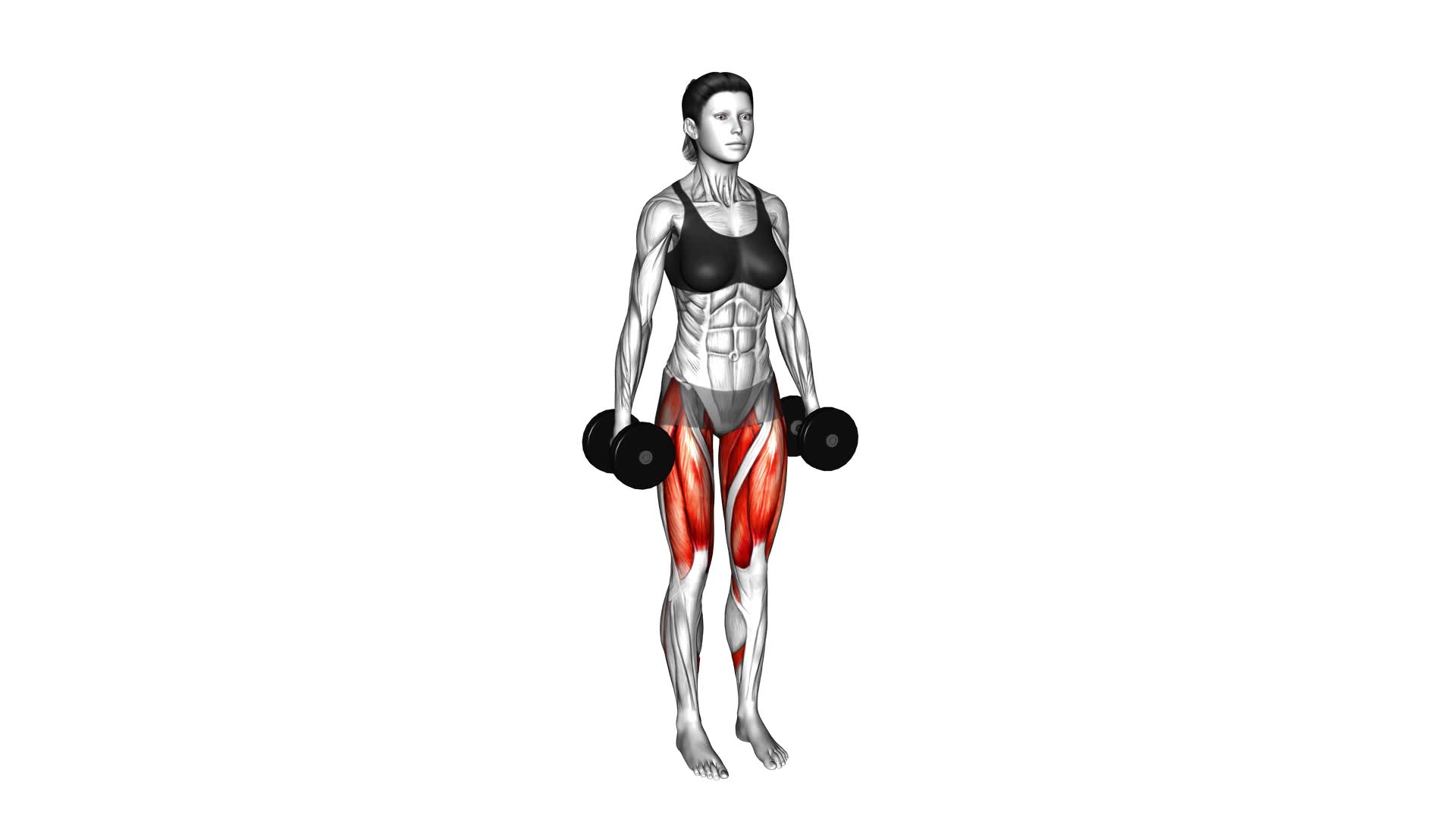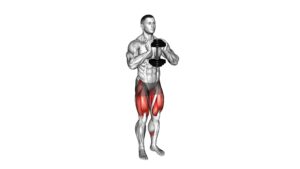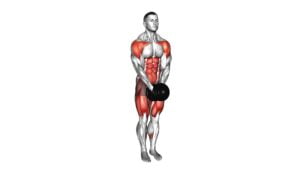Dumbbell Curtsy Lunge (female) – Video Exercise Guide & Tips

Looking to tone your legs and glutes? Try the dumbbell curtsey lunge! This exercise targets multiple muscle groups, helping you build strength and improve stability.
Watch This Exercise Video
In this video exercise guide, we'll show you the proper form and technique, along with modifications for beginners and experienced lifters.
Plus, we'll share tips to maximize effectiveness and common mistakes to avoid.
Get ready to level up your lower body workout with the dumbbell curtsey lunge!
Key Takeaways
- Targets multiple muscle groups: glutes, quadriceps, hamstrings, and adductors
- Builds strength and improves muscle tone in the legs and hips
- Improves balance and stability
- Should be incorporated into lower body workouts at least twice a week
Benefits of the Dumbbell Curtsey Lunge
You will experience several benefits from incorporating the dumbbell curtsey lunge into your workout routine. This exercise not only targets multiple muscle groups but also offers variations to keep your workouts challenging and engaging.
One of the primary benefits of the dumbbell curtsey lunge is its ability to work the lower body muscles effectively. This exercise primarily targets the glutes, quadriceps, hamstrings, and adductors. By performing the curtsey lunge with dumbbells, you add resistance, which further engages these muscles, helping to build strength and improve muscle tone in your legs and hips.
Additionally, the dumbbell curtsey lunge offers variations that can target different muscle groups and add variety to your workouts. For instance, you can perform the exercise with a forward or backward lunge, or add a twist to engage your core. These variations allow you to adjust the intensity and target specific muscles according to your fitness goals.
Incorporating the dumbbell curtsey lunge into your routine can help improve your balance and stability. This exercise requires you to step back and across your body, challenging your coordination and proprioception. Over time, this can enhance your overall athletic performance and reduce the risk of injury.
To reap the full benefits of the dumbbell curtsey lunge, aim to incorporate it into your lower body workouts at least twice a week. Remember to start with lighter weights and gradually increase the resistance as you become more comfortable and stronger.
Proper Form and Technique for the Exercise
To ensure proper form and technique for the dumbbell curtsey lunge, it's important to focus on maintaining a stable and balanced position throughout the exercise. This will help improve knee stability and ensure optimal muscle activation.
Start by standing tall with your feet hip-width apart and hold a dumbbell in each hand by your sides. Take a step back with your left leg, crossing it behind your right leg, and lower your body into a lunge position. Your right knee should be directly above your right ankle, while your left knee hovers just above the ground.
Keep your upper body upright and engage your core to maintain balance. Make sure both heels are firmly planted on the ground and avoid letting your front knee extend past your toes.
As you push through your right heel, return to the starting position and repeat the movement on the other side, crossing your right leg behind your left leg.
Remember to keep the movement controlled and avoid any jerking or swinging motions. By focusing on knee stability and muscle activation, you'll maximize the benefits of the dumbbell curtsey lunge.
Modifications for Beginners and Experienced Lifters
For beginners and experienced lifters, there are several modifications available to make the dumbbell curtsey lunge more challenging or accessible. Whether you're just starting out or looking to take your workout to the next level, these modifications can help you tailor the exercise to your fitness level and goals.
Here are some beginner modifications to consider:
- Start without weights: Begin by performing the exercise without any added weights to focus on mastering the movement and building strength.
- Reduce range of motion: Instead of stepping back into a deep curtsey position, start with smaller steps and gradually increase the range of motion as you get more comfortable.
- Use a chair for balance: If you struggle with balance, place a chair or sturdy object next to you to hold onto for support.
For those looking for a more advanced challenge, try these modifications:
- Increase weight: Hold heavier dumbbells or use a barbell to increase the resistance and target your muscles more intensely.
- Add plyometric jumps: After stepping back into the curtsey lunge, explode up into a jump to engage your fast-twitch muscle fibers and boost your power.
- Incorporate a balance challenge: Instead of stepping straight back, perform the curtsey lunge on an unstable surface like a Bosu ball or balance board to engage your core and improve stability.
Remember to always listen to your body and choose modifications that feel challenging yet safe for you.
Tips for Maximizing the Effectiveness of the Lunge
To maximize the effectiveness of the lunge, it's important to focus on proper form and engage your muscles throughout the entire movement. By doing so, you can maximize your lunge results and achieve the best possible outcome from this exercise.
Here are some tips to help you get the most out of your lunges.
First, pay attention to your posture. Keep your chest lifted, shoulders back, and core engaged. This will help you maintain balance and stability throughout the movement.
Second, make sure you're using your glutes and hamstrings to power through the lunge. As you lower into the lunge, focus on pushing through your front heel to activate these muscles. This will help you build strength and improve your overall performance.
Additionally, try incorporating variations into your lunge routine. For advanced lifters, adding weights such as dumbbells or kettlebells can increase the intensity and challenge your muscles even further. You can also try different lunge variations, such as walking lunges or reverse lunges, to target different muscle groups and keep your workouts engaging.
Remember to listen to your body and adjust the intensity as needed. It's important to push yourself, but also to work within your limits to prevent injury.
With proper form, engagement of muscles, and variations for advanced lifters, you can maximize the effectiveness of your lunges and achieve your fitness goals.
Common Mistakes to Avoid During the Exercise
To ensure proper knee alignment during the dumbbell curtsey lunge, make sure your knees stay in line with your toes and don't collapse inward.
Additionally, it's important to distribute your weight evenly between both legs to maintain balance and stability throughout the exercise.
Knee Alignment Tips
During the Dumbbell Curtsey Lunge exercise, ensure proper knee alignment by keeping your knees directly over your ankles. This is crucial for both knee alignment exercises and knee injury prevention.
Here are some tips to help you maintain correct knee alignment during the exercise:
- Focus on keeping your weight evenly distributed between both feet.
- Avoid letting your knees collapse inward or splay out to the sides.
- Engage your core muscles to stabilize your body and support proper knee alignment.
By following these tips, you can minimize the risk of knee injuries and maximize the effectiveness of the Dumbbell Curtsey Lunge exercise.
Proper Weight Distribution
Maintain proper weight distribution between both feet to prevent common mistakes during the Dumbbell Curtsey Lunge exercise. This exercise requires you to distribute your weight evenly between your front and back foot to ensure proper balance and stability.
When performing the curtsey lunge, it's important to avoid leaning too far forward or backward, as this can throw off your weight distribution and compromise the effectiveness of the exercise. By keeping your weight evenly distributed, you'll be able to maintain proper form and engage all the necessary muscles, such as your glutes, quadriceps, hamstrings, and calves.
Remember, proper weight distribution is crucial for mastering the lunge technique and achieving optimal results.
Now, let's move on to a sample workout routine incorporating the dumbbell curtsey lunge.
Sample Workout Routine Incorporating the Dumbbell Curtsey Lunge
For an effective workout incorporating the dumbbell curtsey lunge, start by including it in a circuit training routine. Circuit training involves performing a series of exercises with little to no rest in between, targeting different muscle groups for a full-body workout. Here's a sample workout routine that incorporates the dumbbell curtsey lunge:
- Warm up: Begin with 5-10 minutes of light cardio, such as jogging or jumping jacks, to get your heart rate up and muscles warm.
- Circuit 1: Perform 10-12 reps of the dumbbell curtsey lunge on each leg, followed by 10-12 reps of push-ups and 10-12 reps of Russian twists.
- Circuit 2: Move on to 10-12 reps of squats with dumbbells, 10-12 reps of bent-over rows with dumbbells, and 10-12 reps of bicycle crunches.
- Circuit 3: Finish off with 10-12 reps of dumbbell shoulder presses, 10-12 reps of tricep dips, and 10-12 reps of mountain climbers.
Repeat each circuit 2-3 times, resting for 1-2 minutes between circuits.
This workout routine not only targets your lower body with the dumbbell curtsey lunge but also engages your upper body and core muscles with the other exercises. Remember to choose dumbbell weights that challenge you but still allow for proper form and control.
Happy training!
Frequently Asked Questions
How Heavy Should the Dumbbells Be for the Dumbbell Curtsey Lunge?
For the dumbbell curtsey lunge, the weight of the dumbbells depends on your fitness level and strength. Start with a weight that challenges you but still allows you to maintain proper form. As you progress, you can gradually increase the weight.
It's important to choose a weight that you can control throughout the exercise without compromising your posture or risking injury. Find a weight that feels challenging but manageable for you.
Can the Dumbbell Curtsey Lunge Help With Improving Balance?
Improving balance and core strength are key benefits of the dumbbell curtsey lunge. By incorporating this exercise into your routine, you can enhance your ability to maintain stability and control during movement.
The unique lateral stepping motion of the curtsey lunge engages the muscles in your legs, hips, and core, helping to strengthen and stabilize these areas.
This exercise is a great addition to any fitness program, providing a challenging way to improve both balance and core strength.
Is It Necessary to Perform the Dumbbell Curtsey Lunge on Both Sides?
To answer your question, yes, it's necessary to perform the dumbbell curtsey lunge on both sides.
This exercise targets different muscle groups on each side of your body, helping to promote symmetry and balance.
By performing the exercise on both sides, you ensure that you're strengthening and toning your entire lower body evenly.
Plus, it allows you to work on any imbalances or weaknesses that you may have.
Can the Dumbbell Curtsey Lunge Help With Toning the Inner Thighs?
The dumbbell curtsey lunge is a great exercise for toning your inner thighs. By crossing one leg behind the other and lunging down, you engage the muscles in your inner thighs, helping to strengthen and tone them.
This exercise also targets your glutes, quads, and hamstrings, giving you an overall leg workout. To target different muscle groups, you can vary the position of the dumbbells or add extra resistance.
How Often Should the Dumbbell Curtsey Lunge Be Included in a Workout Routine?
To get the most out of your leg focused workout routine, it's important to include the dumbbell curtsey lunge. This exercise offers a variety of benefits, such as toning the inner thighs and strengthening the glutes.
To perform it properly, start by standing with your feet shoulder-width apart and holding dumbbells at your sides. Then, step your right foot behind and to the left of your left foot, bending both knees.
Repeat on the other side for optimal results.
Conclusion
Incorporating the dumbbell curtsey lunge into your workout routine can provide numerous benefits, such as strengthening your lower body muscles and improving balance.
By following proper form and technique, beginners and experienced lifters can modify the exercise to suit their fitness level.
Maximizing the effectiveness of the lunge can be achieved by focusing on the mind-muscle connection and maintaining control throughout the movement.
Avoiding common mistakes will ensure a safe and efficient workout.
Try adding the dumbbell curtsey lunge to your next workout for a challenging and effective lower body exercise.

Author
Years ago, the spark of my life’s passion ignited in my mind the moment I stepped into the local gym for the first time. The inaugural bead of perspiration, the initial endeavor, the very first surge of endorphins, and a sense of pride that washed over me post-workout marked the beginning of my deep-seated interest in strength sports, fitness, and sports nutrition. This very curiosity blossomed rapidly into a profound fascination, propelling me to earn a Master’s degree in Physical Education from the Academy of Physical Education in Krakow, followed by a Sports Manager diploma from the Jagiellonian University. My journey of growth led me to gain more specialized qualifications, such as being a certified personal trainer with a focus on sports dietetics, a lifeguard, and an instructor for wellness and corrective gymnastics. Theoretical knowledge paired seamlessly with practical experience, reinforcing my belief that the transformation of individuals under my guidance was also a reflection of my personal growth. This belief holds true even today. Each day, I strive to push the boundaries and explore new realms. These realms gently elevate me to greater heights. The unique combination of passion for my field and the continuous quest for growth fuels my drive to break new ground.







